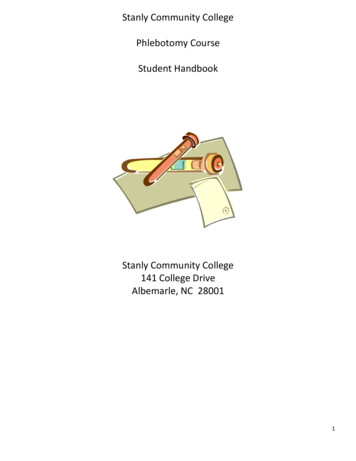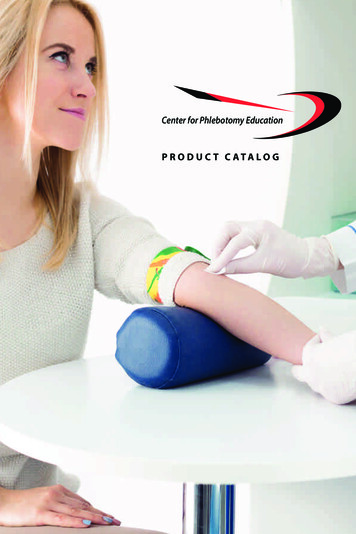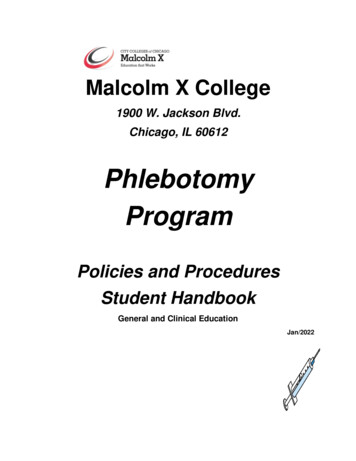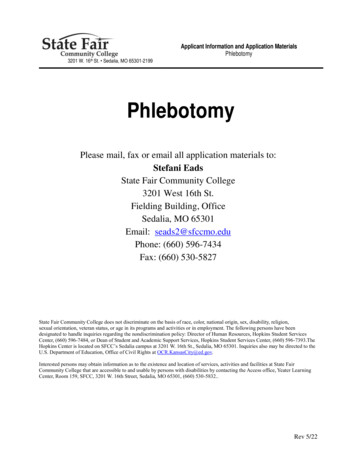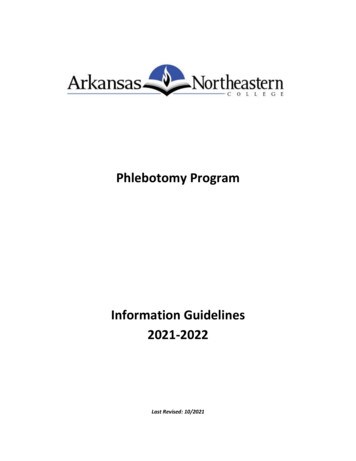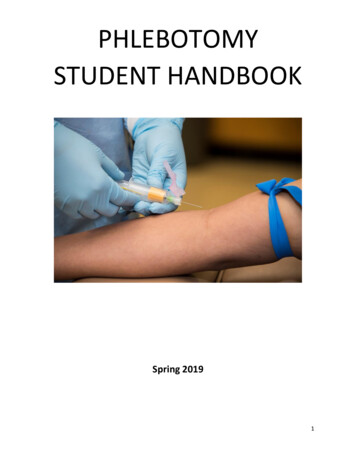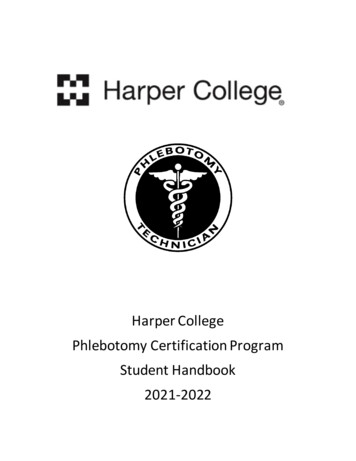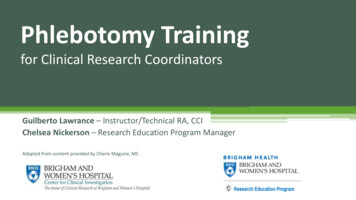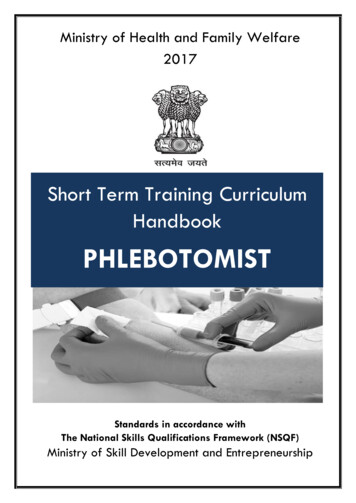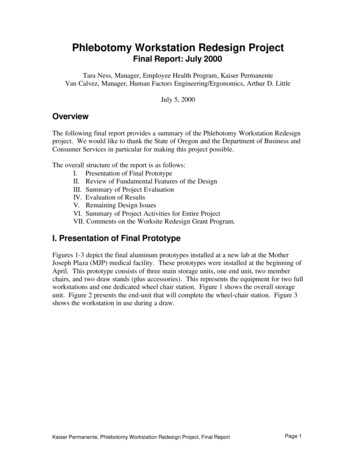
Transcription
Phlebotomy Workstation Redesign ProjectFinal Report: July 2000Tara Ness, Manager, Employee Health Program, Kaiser PermanenteVan Calvez, Manager, Human Factors Engineering/Ergonomics, Arthur D. LittleJuly 5, 2000OverviewThe following final report provides a summary of the Phlebotomy Workstation Redesignproject. We would like to thank the State of Oregon and the Department of Business andConsumer Services in particular for making this project possible.The overall structure of the report is as follows:I. Presentation of Final PrototypeII. Review of Fundamental Features of the DesignIII. Summary of Project EvaluationIV. Evaluation of ResultsV. Remaining Design IssuesVI. Summary of Project Activities for Entire ProjectVII. Comments on the Worksite Redesign Grant Program.I. Presentation of Final PrototypeFigures 1-3 depict the final aluminum prototypes installed at a new lab at the MotherJoseph Plaza (MJP) medical facility. These prototypes were installed at the beginning ofApril. This prototype consists of three main storage units, one end unit, two memberchairs, and two draw stands (plus accessories). This represents the equipment for two fullworkstations and one dedicated wheel chair station. Figure 1 shows the overall storageunit. Figure 2 presents the end-unit that will complete the wheel-chair station. Figure 3shows the workstation in use during a draw.Kaiser Permanente, Phlebotomy Workstation Redesign Project, Final ReportPage 1
Figure 1. Overall Views of the Final Prototype at MJPNote in Figure 1 the newly added bungee cords to hold the wastebaskets in place. Thiseliminates the possibility of patients kicking the wastebasket over onto the floor.Figure 2. End-Unit at MJPKaiser Permanente, Phlebotomy Workstation Redesign Project, Final ReportPage 2
Figure 3. Workstation In Use at MJPFigure 4 depicts several sizes of arm stabilizers that were built for the final prototype.The unit on the right was designed to be used for smaller children. The phlebotomistshave discovered that the arm stabilizers are very helpful for restraining a small child’sarm.Figure 4. Multiple Sized Arm StabilizersKaiser Permanente, Phlebotomy Workstation Redesign Project, Final ReportPage 3
II. Review of Fundamental Features of the DesignThe following is a summary of the primary features of this workstation design.Overall Concept Phlebotomist stands during the draw (with the option to sit occasionally and fordrawing patients in wheel chairs) Member sits during the draw Smaller, moving draw surface with a fixed member chair (member is the reference) Member would extend arm to the side of body during the draw Member sits sideways (facing one of the partitions) during the drawDraw Surface Draw surface is vertically adjustable by phlebotomist Draw surface is also adjustable horizontally Draw surface has a functional depth of 16” and has a convex circular shape on thephlebotomist side to allow the phlebotomist to access the member’s arm frommultiple angles without increasing the reach distance. Draw surface has an overall size of approximately 18”x28”. Recessed areas on draw surface to prevent blood tubes from rolling off the table top. Movable accessory (arm stabilizer) to guard member’s hand and angle the arm.Member Chair Member chair is vertically adjustable by the phlebotomist (e.g., foot pump) Member chair would be left in a higher position (seat height approximately 25”) formost members. The chair would only be lowered for members with difficulty sittingin the higher chair. Headrest integrated into backrest of chair.Supplies Retain most supplies (e.g., one-days supply) built into a storage unit that also servesas a partition between workstations. Supply storage is flexible to allow for variations in needs and changes over time. Critical supplies are duplicated on the left and right hand sides of the workstation. Integrating supplies into partitions and/or draw surface minimizes member’s view ofsupplies and equipment.Kaiser Permanente, Phlebotomy Workstation Redesign Project, Final ReportPage 4
II. Review of Fundamental Features of the Design (cont.)Member Issues Member is protected from falling out of the chair by: Having the member recline slightly in the chair during the draw Supporting the member’s feet with a foot rest Having a moving work surface which can be pushed towards the member tohold them in the chair (or moved out of the way to access the patient) Having a swivel lock option in member’s chair Member storage is integrated into the partitions. A dedicated wheel chairs station is identical to a regular workstation (except withoutthe patient chair). Phlebotomists are encouraged to sit while drawing wheel chairusers. Use of a baby tray that attaches to the draw stand for drawing infants (still indevelopment).Kaiser Permanente, Phlebotomy Workstation Redesign Project, Final ReportPage 5
III. Summary of Project EvaluationTable 1 is a summary of the evaluation results for the phlebotomy workstation redesign.Although long-term data will continue to be collected for one metric, the evaluation hasrevealed that the workstation produced positive results on all metrics. Based on theseresults, it would be reasonable to consider this new workstation a dramatic improvementover past designs and a huge success overall.Table 1. Summary of the Results of the Project EvaluationMetric1. Improve ormaintain the abilityto completemedicallyappropriate andsafe blood draws.2. Improve staffsatisfaction andcomfort.3. Improve customerservice andsatisfaction.Result Satisfied all criteria.Received an “A” rating on 92% (11 out of 12) of testablecriteria. 91% of phlebotomist’s satisfaction ratings weresignificantly improved for the new workstations. Many positive patient comments about the handrails andpatient chair.No negative patient comments reported. 4. Improveefficiency. Workstation at least supports current blood draw efficiency.Workstation improves efficiency in many small ways andmay produce measurable results after additional testing.5. Reducemusculoskeletalrisk factors. The final workstation was found to reduce the overallmusculoskeletal risk rating from Medium Risk to Low Risk.Reduced awkward wrist postures 73%.Reduced awkward reaching by 87%.Reduced awkward bending by 91%.6. Reduce risk ofaccidents. 7. Reduce injuriesand workers’compensationcosts. 8. Meet performanceand functionalrequirements. Eliminated or significantly reduced 92% of identifiedaccident risk factors.Eliminated 46% of accident risk factors.Injury and workers’ compensation data not available at thispoint.No identified phlebotomist discomfort associated with thenew workstations.Tracking of this metric will continue.Satisfied all criteria.Received an “A” rating on 92% (57 out of 62) of testablecriteria.Kaiser Permanente, Phlebotomy Workstation Redesign Project, Final ReportPage 6
IV. Evaluation of ResultsOur grant application specified metrics to be used in evaluating the effectiveness of thedesign. The following sections present the result of these evaluations.The objectives with their expected metrics are listed below:1. Improve or maintain the ability to complete medically appropriate and safe blooddraws. Objective 1 will be measured using operational metrics to be defined in theinitial technical research.2. Improve staff satisfaction and comfort. Objective 2 will be measured using avalidated survey instrument.3. Improve customer service and satisfaction. Objective 3 will be measured usingcustomer phone surveys and on-site interviews, as well as wait time measurements.4. Improve efficiency. Objective 4 will be measured using time measures includingaverage time for a blood draw, customer wait time in lobby, customer wait time inphlebotomy area, turn-around time for test results.5. Reduce musculoskeletal risk factors. Objective 5 will be measured using anergonomic checklist, postural analysis, and upper-limb elemental task analysis.Predictive modeling will be used to assess the impacts of the potential solutions onmusculoskeletal risk factors. Those factors include: the number of repetitive motions,the postures of the back, lower limbs and upper limbs, the type of grips, and theamount of force being exerted.6. Reduce risk of accidents. Objective 6 will be measured using cognitive task analysisand human error analysis methods.7. Reduce injuries and workers’ compensation costs. Objective 7 will be measuredusing workers’ compensation claims data.8. Meet performance and functional requirements. Objective 8 will be measured bycomparing the resulting design to performance and functional requirements.Kaiser Permanente, Phlebotomy Workstation Redesign Project, Final ReportPage 7
A. Objective 1. Improve or maintain the ability to completemedically appropriate and safe blood draws.These criteria originate from our initial Phlebotomist Input Session conducted March 30,1999. In addition, we reviewed the Phlebotomy Handbook (Garza and Becan-McBride,1996) for additional criteria. The ratings of performance presented in Table 2 werecompleted by the ergonomist because the evaluations were based on concrete, observablecharacteristics of the workstation. The ratings were then reviewed and edited by theDesign Team. The ratings were completed using an A-F grade scale, A being best, Fbeing worst.Table 2. Evaluation of the Ability to Complete Medically Appropriate andSafe Blood DrawsCriteria for Medically Effective andConsistent Blood DrawsKeep the arm stable throughout the blooddraw process. This is the most importantfactor in an effective blood draw. Avoidany bumps, sudden movements, orchanges in contraction in the member’sarm muscles.RatingThe arm should be almost straight. Thisstraightens the vein and makes the skinmore taut.Individual differences heavily influencearm postures needed to facilitate a draw.Therefore, flexibility in the workstation isimportant.Line up with vein running fore-aft infront of body.The elbow should be supportedthroughout process.APhlebotomists draw “by feel”, not by eye.The forearm can be horizontal or angleddown slightly.AAPatients can squeeze an object or make aAB How Does the Design Satisfy theCriteria?Phlebotomists found the draw stand to bestable and safe to use for blood draws. Aslight wiggle in the draw stand upright isthe only criticism. While the wiggle doesnot seem to impact draw performance, itcould increase risk of a problem if thetable is bumped during the draw. If thisis wiggle can be eliminated, the Ratingwould be “A”. This rating also assumesthat the draw stand base will continue tobe adequately weighted to counteract anyforeseeable tipping forces.A mobile, height adjustable draw surfacefacilitates this.AA mobile, height adjustable draw surfacefacilitates this.AA small, circular worksurface facilitatesthis.The design permits this to be satisfiedeither while the elbow is on the drawsurface or on the elbow wedge.The design incorporates this need.Using the elbow wedge allows arm to beangle down slightly. If the elbow wedgeis not used, the forearm is automaticallyhorizontal.The arm stabilizer is provided to give theAKaiser Permanente, Phlebotomy Workstation Redesign Project, Final ReportPage 8
tight fist but should be advised to notsqueeze repeatedly (this causes elevatedpotassium levels).Phlebotomists often use their fingers to“anchor” the vein (hold the vein in placeto keep it from moving or rolling).The needle angle with respect to thesurface of the skin should beapproximately 15 degrees.The patient’s arm should be as low aspossible (for patient comfort) whilemaintaining as open an arm angle aspossible for the blood draw.Resting the arm on a padded surface ishelpful for the patient’s comfort.patient an object to squeeze.AThe design incorporates this need.AThe mobile, height adjustable drawsurface facilitates the correct needleangle.The mobile, height adjustable drawsurface allows the correct arm posture.AAA padded wedge is available for use atthe workstation.Kaiser Permanente, Phlebotomy Workstation Redesign Project, Final ReportPage 9
B. Objective 2. Improve staff satisfaction and comfort.Table 3 presents the results of the Staff Satisfaction Survey. The baseline survey wascollected from 19 phlebotomists at three different labs in June of 1999. The final surveywas collected from five phlebotomists with substantial experience using the prototypeworkstation. In all cases, phlebotomist rated statements on a 5-point scale, where 5indicates, “strongly agree”, and 1 indicates, “strongly disagree”. The table presents theaverage scores for each question and the results of a two-tailed T-test conducted for eachquestion. This T-test was used to determine if there were significant differences betweenthe baseline scores and final scores (at the 0.05 level of confidence).A review of Table 3 indicates that the phlebotomists gave the new workstationsignificantly higher satisfaction ratings on the vast majority of questions. Out of 50questions, 41 questions (82%) scored significantly higher for the new workstation, 4questions (8%) did not score significantly higher, and 5 questions (10%) did not haveadequate data to test. Of those questions that did not score significantly higher, themajority of these involved Draw scenarios that the phlebotomist was not able to experience in order to evaluatethe station properly. Defects in the current prototype that are in the process of being fixed.Table 3. Results of the Staff Satisfaction Survey (1-5 .NewRatingT-TestResult(p value)T-Test Finding(p ent2.944.800.000052.944.600.00036 Sharps container forbutterfly needles Improvement3.224.800.00009 Needles3.284.800.00013OverallOverall, this workstation iseffective, efficient, and welldesignedThe workstation iscomfortable and convenientfor meThe workstation seems to becomfortable and convenientfor membersSupplies/Location of supplies isEquipment effective (overall)Also for specific items: Primary sharps container Kaiser Permanente, Phlebotomy Workstation Redesign Project, Final ReportSignificantImprovementSignificantPage 10
Workstation Tourniquets3.284.400.04544 Tubes2.894.800.00001 Sink2.835.000.00000 Computer2.654.000.12630 Overall amount ofworkspace is adequateWork surface is at theright height for drawingWork surface is at theright height for writingWork surface is wideenough (left to right)Work surface is thecorrect depth (fore-aft)Workstation preventstubes from falling on thefloorLeg room adequate formembersSpace around theworkstation adequate fortraffic flowMembers can get in andout of chairs easilyChairs are .00632Chairs are at the rightheight for members Chairs do not have to bemoved Chairs are easy to move Chairs are comfortablefor membersWorkstation is effective for avariety of sized staff.Specifically for: Tall 0.001442.334.500.000352.214.500.00020 2.754.670.00491 Chairs PhlebotomistsShort staffKaiser Permanente, Phlebotomy Workstation Redesign Project, Final vementSignificantImprovementSignificantPage 11
Members Heavy staff2.584.670.00496 Pregnant staff2.394.500.09411 Right-handers2.794.500.00183 Left-handers2.764.000.15279Workstation is effective fordrawing a variety of patients.Specifically for: Tall members2.634.500.089802.894.600.00027 Short members2.634.600.00007 Heavy members2.634.750.00011 Babies2.63N/A Small children inparent’s lapChildren sitting bythemselvesWheelchair Members who arefrightened/ tenseMembers who faint2.793.750.019152.473.500.02699Members who mustpartially remove shirtPregnant 63 Helps the member feel atease/ minimizes stressDrawing from both arms2.684.600.00013 Drawing from the hand3.114.400.02697 Drawing blood from thefingerDrawing blood fromother locations (e.g.,upper arm)3.004.000.216062.944.200.02447 MembersCont. Kaiser Permanente, Phlebotomy Workstation Redesign Project, Final ata vementSignificantImprovementData NotAvailable**Data ntSignificantImprovementData ificantImprovementPage 12
* Not significant result based primarily on defects in the current prototype that are in theprocess of being fixed.** “Not significant” result based primarily on lack of opportunity to test this particulardraw situation.*** N/A in this case means that the chair is bolted down. Therefore, there is no need forthe chair to be easy to move.In support of the satisfaction ratings, the following baseline staff comments werecollected regarding various existing workstations.Skyline Lab Phlebotomist Comments Because I am tall it makes it hard to draw and gives me a back ache Workstation is too low have to bend over to far and always asking the patient to movecloser Poorly organized. These workstations each differ enough to make a too confusing. Itis too low for drawing and has a "crowded-in" feeling. Workstations have a fixed height and depth and are at the wrong height and depth.It's a back killer. Supplies are below the counter, have to stoop. Hard on back. Chairs are not adjustable. Only complaint counter is too deep. Too much space between the patient and eye. Ihave to lean over too much. Bad wheelchair access. Middle workstation is too narrow. Tubes roll away from the wheelchair access table. A lot of patients have difficulty moving chairs close to counter. We need somewhere comfortable for our wheelchair patients. Leaning over aggregates a neck and back injuryBeaverton Lab Phlebotomist Comments If I wear shoes with a steel it is more comfortable. If I don't, it's too high. Patients have difficulty getting in and out of draw station. The chairs are too big andthey hit their knees on it as they get in. There isn't adequate legroom for patients. It's too shallow. The patient' s knees aretouching the station but their upper body isn't close enough. The workstation is too small, too cramped for employees, no room for babies. Need a bigger drawing area. Too many patients here. We are constantly bumping into one another has with pass-through, turnaround, etc. The chairs are not user-friendly. They need to adjusting all the time and are notcomfortable for the patients. Patients can fall out of the chairs. We have had 2-3older patients fall out of chairs. The dividers between stations have minimal confidentiality and patients havecomplained that they feel like cattle in a stall. The workstation is too tall for shorter phlebotomists. Patients have problems gettingin and out of the stations, especially elderly patients. The workstation does not prevent tubes from falling on the floor.Kaiser Permanente, Phlebotomy Workstation Redesign Project, Final ReportPage 13
The bed is too high to put it patient that has fainted.North Lancaster Lab Phlebotomist Comments I can get close to the patient. I don't have to bend forward too much What I like least about this workstation is the angle of the draw that is hard on thewrist, arm and back due to twisting. There is no privacy between workstations for patients. Two out of the three stations are difficult to draw from both arms. Not enough room for tubes. Tubes are in and okay place. Some older and heavier people aren't able to move all the way back in the seatconsequently making it harder to draw. Not enough room. Bad the angle. Not enough room for garbage. Too low. Get ridof it There is room to the left but there is no room to the right. No room to fit a child sitting in a parent's lap. It is easy for patients to get in and out of the workstation I don't like drawing blood from the side and having to reach over and get to us to use. The right side is against the wall, no space to draw. I'm short so the gloves are a bit hard to reach. Easy access to blood drawing equipment. Possible to pinch patient’s hand in drawer. Supplies are hard to get, have to bend down have to move members hand out of theway. When drawing from the patients left arm, there is no place to put tubes withoutreaching over under the patients arm. Have to reach across body to access sharp container. Patients must up to the seat before they can sit down. Would like to draw more from the side of the patient. Must access the patient headon.In comparison, the following are staff comments collected from phlebotomists that haveused the new prototype workstation.New Workstation Phlebotomist Comments The new stations work great! I like how all the supplies are at arms reach and at your fingertips. You don't have tosearch or reach very far for any one thing. The recessed trays are great for preventing tubes from falling on the floor. Easy for member to get in and out of chair. Positioning is easier also. User-friendly.Patient-friendly. Patients really like the handrails. I like the adjustable workstation. It means less bending and reaching. I like having access to sharps with both hands within arms reach Supplies out of reach for patients (patients can’t access supplies).Kaiser Permanente, Phlebotomy Workstation Redesign Project, Final ReportPage 14
The built-in sharps container for butterflies and syringes is wonderful because you donot need to run around carrying exposed needles.The following are phlebotomist comments on remaining issues. All of these issues willbe addressed this year. It is inconvenient to lock and unlock all three wheels to move table. Footrest needs to be moved back to make it easier for the patient to get in the chair. The draw table is too high for wheelchair users. Patient’s chair hits table when the patient is getting out of the chair. This tends tomark up the draw table.C. Objective 3. Improve customer service and satisfaction.There presently has not been a sufficient volume of testing of these workstations in orderto warrant a Kaiser Permanente customer phone survey to date. Since Kaiser PermanenteLabs have discontinued regular phone surveys for the time being, it is not expected that aphone survey will be feasible. However, Kaiser Permanente does routinely track patientcomplaints and will continue to do so for these new workstations.Numerous patient complaints of the pre-existing workstations have been identified.These complaints include the following: Clutter on the workstation. Uncleanliness (e.g., reusing used gauze). Difficulty getting in and out of chairs. Falling out of chairs after fainting.A number of informal patient comments of the new workstation were solicited during thetesting of prototypes and during the final assessment. The most common patientcomment on the workstations was that they liked the handrails. Patients also commentedpositively on the large wide chair that seemed very secure to them. Patients also liked thefootrest on the chair and indicated that they thought getting in and out of the chair wasfairly easy. The following patient comment basically sums up patient comments on thenew workstation, "I think this new station is a very neat and comfortable." To ourknowledge, we have received no negative comments on the workstation from patients.During the testing of the new workstation, we did have one patient faint. According tothe phlebotomists on the scene, the patient remained safely in the chair. Therefore, theworkstation successfully passed this important test. Once several improvements areimplemented to the chair (strengthening the backrest and adding a headrest), the chairwill be even more effective for protecting fainting patients.D. Objective 4. Improve efficiency.The time measurements could find no significant differences in average draw timesbetween the final prototypes and baseline measures. Average draw times still runapproximately two minutes for both baseline and prototype workstations. This isKaiser Permanente, Phlebotomy Workstation Redesign Project, Final ReportPage 15
partially due to the fact that the workstation redesign generally did not change the actualblood draw tasks, it changed the workstation used for those tasks. For instance, byimproving the location of the supplies, the amount of time required to reach for thosesupplies was only slightly reduced.While draw times were not reduced, the efficiency of the workstation was improved inother ways. For example, by organizing and standardizing the workstation, this helpsphlebotomists quickly change from workstation to workstation and from lab to lab.Some opportunities for increasing efficiency at the workstation were examined andrejected during the design process. For example, finding the edge of tape on a tape role isa time-consuming activity. During the design, we investigated outfitting the workstationwith tape dispensers. However, we found that many phlebotomists disliked tapedispensers. For example, they generally preferred to hold the entire tape roll in theirhand. Also, we were unable to find an appropriate tape dispenser that would fit in theworkstation. Therefore, after much effort, we abandoned the tape dispenser idea. Weprovided a location in the design for phlebotomists to neatly hang a roll of tape.One of the major ways in which the efficiency of the workstation was improved was bystreamlining of the movement of supplies travel at the workstation. In traditionalworkstation designs, supply and trash storage were generally inefficiently located. Thisencouraged phlebotomists to place supplies on the worksurface before and after use. Themajor problem with this is that it creates a cluttered and unsanitary appearance for thepatient. The new workstation was designed so that supplies travel directly from storageto use to disposal. This not only helps create a more clean appearance, it helps thephlebotomist to work more efficiently. For example, it takes less time to dispose ofsomething directly after use than it does to place it on the workstation and then later pickit up and dispose of it. However, the phlebotomist must employ this technique whileworking. Therefore, training is an important component of this change. While thischange has not produced any measurable reductions in draw time to date, this may be theresult of lower volume use of the workstations. It might be possible to measureimprovements in efficiency once these workstations have been installed at a high-volumelab. In any case, we do not expect that the increase in efficiency will be dramatic.Nevertheless, we consider it a success that the workstation does not in any waycompromise the efficiency of the blood draw task and certainly improves efficiency inseveral intangible ways.Kaiser Permanente, Phlebotomy Workstation Redesign Project, Final ReportPage 16
E. Objective 5. Reduce musculoskeletal risk factors.The analyses of musculoskeletal risk factors were completed for both the baselineworkstation (Mt. Talbert Lab) and the final prototype workstation (MJP Lab). Mt.Talbert was selected as the baseline because it was representative of the types ofproblems that occurred with the existing workstations. Other existing labs were includedin the assessment of the baseline in order to ensure there were no major differences fromthe Mount Talbert lab. Video was collected in each case during task performance. Theanalysis for the final prototype assumes that the phlebotomist is using the recommendedtechniques for task performance and workstation use.The Ergonomics Checklist Assessment is a brief analysis method for determining theoverall level of musculoskeletal risk factors. A checklist was completed for both thebaseline and final prototype videotapes. Table 4 presents the checklist results by bodyregion for the baseline and the final prototype. The Overall Score equals the highestBody Region Score. Risk ratings are determined by the following scale: High 10 ,Med 5-9, and Low 0-4. The circled scores indicated the highest score for that task.Table 4. Checklist oLegs/FeetHead/EyesBaselineMt. Talbert LabFinal PrototypeMJP owNote: The circles indicate those body regions with the highest individual risk rating.The checklist results indicate a Medium Risk for the baseline measurements due to riskfactors in the hands/wrists/arms, shoulder/neck, and the legs/feet. The final prototype wasfound to reduce the overall risk rating to Low Risk.Two detailed musculoskeletal analysis methods were employed: Postural Analysis andUpper-Limb Elemental Task Analysis. Both of the analysis methods are based on reviewof videotape and documentation of awkward postures/movements that occur at each taskstep. The Postural Analysis focuses on continuous postures while the Elemental TaskAnalysis focuses on repetitive movements. Table 5 compares the postural and elementaltask analysis results for both the baseline and final prototype workstations.Table 5. Impact of New Workstatio
Kaiser Permanente, Phlebotomy Workstation Redesign Project, Final Report Page 8 A. Objective 1. Improve or maintain the ability to complete medically appropriate and safe blood draws. These criteria originate from our initial Phlebotomist Input Session conducted March 30, 1999. In addition, we reviewed the Phlebotomy Handbook (Garza and Becan .
